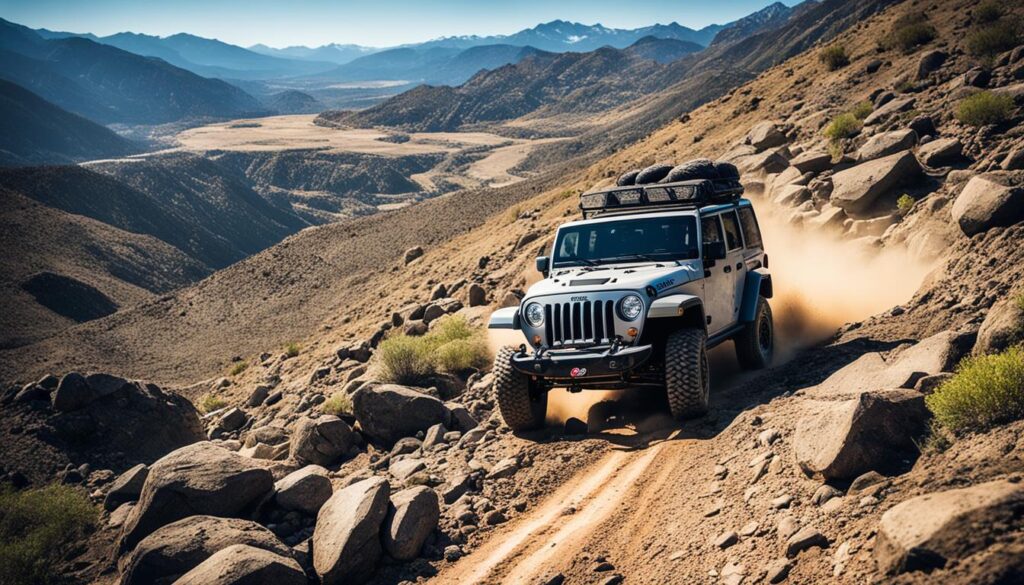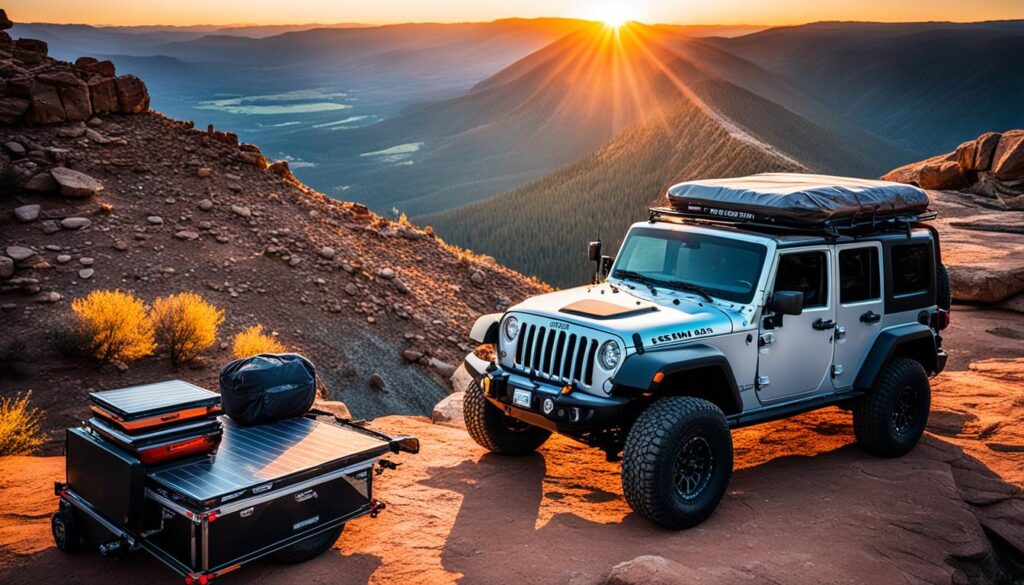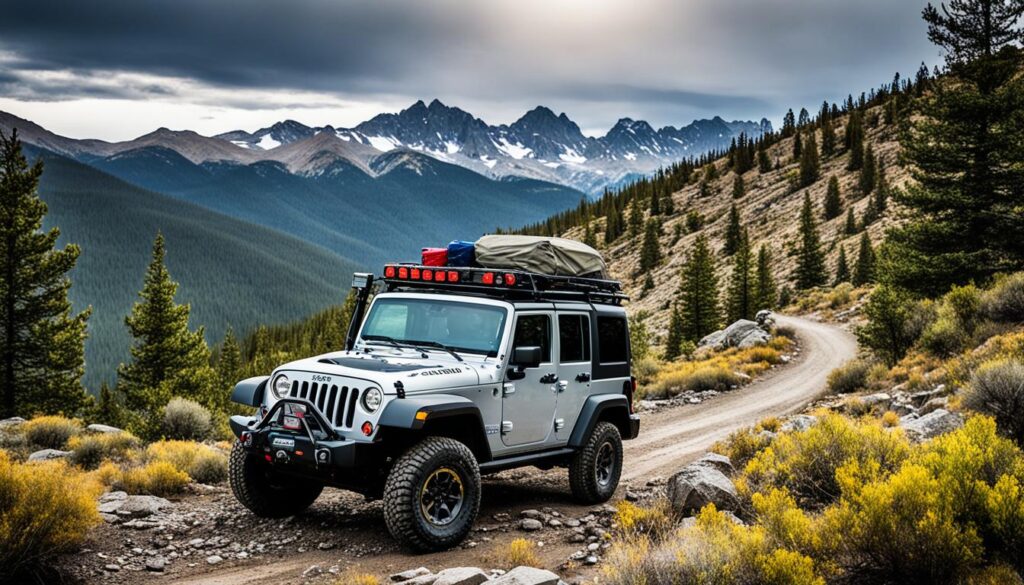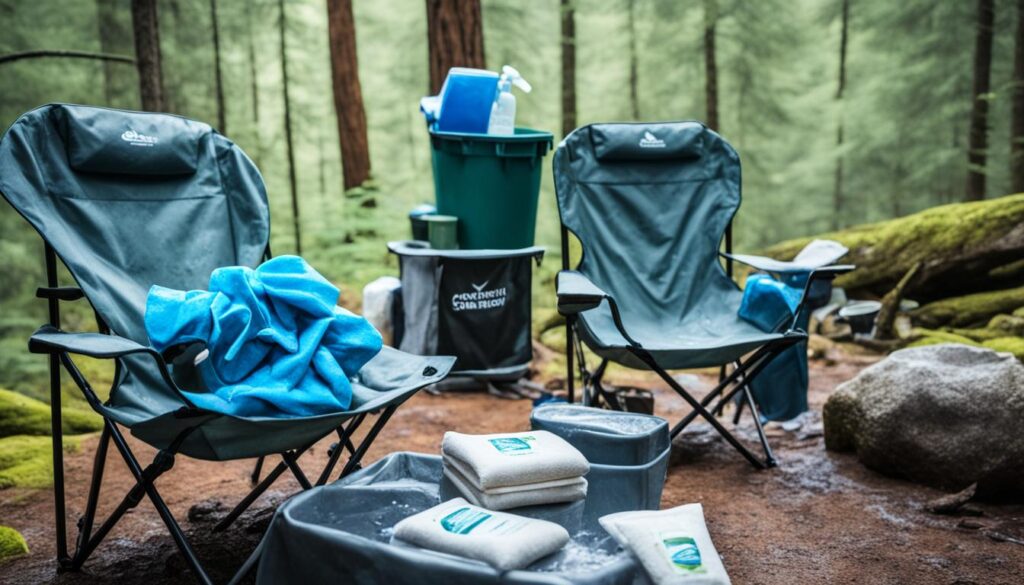Have you ever wondered what it takes to embark on an off-road adventure, exploring the untamed beauty of American landscapes? Well, get ready to immerse yourself in the world of Jeep overlanding – a thrilling and self-reliant way to travel off the beaten path.
In this article, we will delve into the exciting realm of off-road adventures, where Jeep enthusiasts embrace the challenges of remote locations and the freedom of the open road. From the origins of overlanding to the essential gear needed for an unforgettable journey, we’ll uncover what makes Jeep overlanding a unique and compelling experience.
So, fasten your seatbelts, and let’s discover the exhilarating world of Jeep overlanding together. Your next off-road adventure awaits!
Key Takeaways
- Overlanding combines off-road exploration and self-reliant travel in a Jeep or other off-road vehicles.
- It allows enthusiasts to connect with nature, embrace camping culture, and explore new places.
- Overlanding originated in Australia and has become popular worldwide.
- Jeep vehicles are renowned for their off-road capabilities and 4×4 systems.
- Essential gear for overlanding includes water, food, tools, and camping supplies.
Overlanding has its roots in the early 1900s, tracing back to the vast Australian continent and its extensive trade routes. These routes initially served the purpose of facilitating long-distance travel for trading farm animals. However, they soon garnered the attention of outdoor enthusiasts seeking to explore the untamed beauty of the Australian landscape.
One key figure who played a pivotal role in shaping overlanding as an outdoorsman activity was Leonard “Len” Beadell. Beadell, a renowned road builder and pioneer, embarked on numerous expeditions to construct roads and survey sites in remote regions of Australia. His adventures not only opened up new pathways for exploration but also showcased the potential of long-distance overland travel.
“Overlanding began as a means of traversing the Australian trade routes, but it soon evolved into an endeavor that embraced the spirit of adventure and exploration.”
Driven by the desire to connect with nature and discover uncharted territories, overlanders began venturing into remote and challenging environments. These early pioneers laid the foundation for the modern concept of overlanding, which has since evolved into a global phenomenon, transcending continents and captivating the imagination of adventurers worldwide.
The Australian Trade Routes
The Australian trade routes were integral to the origins of overlanding. These routes were initially established to facilitate the movement of livestock across vast distances. As these routes expanded and connected different regions, they attracted the attention of individuals looking for unique outdoor experiences.
Traversing these trade routes provided an opportunity to explore diverse landscapes, including deserts, mountains, and coastal regions. The rugged terrain and the sense of freedom offered by the Australian outback captivated the hearts of many, leading to the emergence of overlanding as a popular activity.
“The Australian trade routes served as a pathway to adventure, offering overlanders a chance to experience the vastness and beauty of the country’s diverse landscapes.”
Today, the legacy of these trade routes lives on in the spirit of overlanding, as off-road enthusiasts continue to seek out remote locations, pushing the boundaries of exploration and embracing the challenges that lie ahead.
What Sets Overlanding Apart
While overlanding involves elements of camping and off-roading, it sets itself apart by focusing on long-distance travel to remote and underexplored locations. It goes beyond traditional camping by delving into the unknown and staying off-grid for extended periods of time.
Overlanding enthusiasts embrace off-roading challenges such as navigating boulders, water crossings, mud, and dry lakebeds. The journey itself is the primary goal, and exploration in uncharted territories is a significant draw for overlanders.
Exploring Remote Locations
One of the key distinguishing factors of overlanding is the journey to remote and off-the-beaten-path locations. Unlike traditional camping, which often takes place in established campsites, overlanding encourages travelers to venture into unexplored territories. This allows overlanders to experience the thrill of discovery and escape the crowded tourist destinations.
Remote locations offer a sense of solitude and a connection with nature that is unmatched. Overlanders can immerse themselves in stunning landscapes, from rugged mountains to pristine beaches to vast deserts. These secluded spots provide an opportunity to disconnect from the hectic pace of everyday life and truly appreciate the beauty of the natural world.
Thriving on Off-Roading Challenges
Overlanding also sets itself apart through the exhilarating off-roading challenges that enthusiasts eagerly embrace. As overlanders navigate through rugged terrains and unpredictable conditions, they encounter obstacles that test their driving skills and the capabilities of their vehicles.
From traversing rocky terrain to conquering water crossings, overlanders push the limits of their vehicles to reach their destination. These off-roading challenges add an element of excitement and adventure to the journey, creating unforgettable memories along the way.

| Key Differences Between Overlanding and Camping | |
|---|---|
| Overlanding | Camping |
| Focus on long-distance travel to remote and underexplored locations | Usually takes place in established campsites |
| Off-road exploration and challenging terrain | Typically on established roads and trails |
| Self-sufficiency and staying off-grid | Reliance on amenities and facilities |
| Emphasis on the journey and exploration | Focus on the destination and relaxation |
Gear and Equipment for Overlanding
Overlanding requires the right gear and equipment to ensure a successful and enjoyable trip. Whether you’re embarking on a solo adventure or traveling with a group, having the essential equipment can make all the difference. Here is a rundown of the must-have overlanding gear:
1. Vehicle:
Various vehicle types, including SUVs, trucks, and vans, can be transformed into capable overlanding rigs. Popular models for overlanding adventures include the Jeep Grand Cherokee and the legendary Wrangler, known for their off-road capabilities and durability.
2. Essential Gear:
When it comes to overlanding, it’s crucial to be prepared for any situation. Some of the essential gear includes:
- Water: Carry an ample supply of drinking water to stay hydrated, especially when venturing into remote areas.
- First-Aid Kit: A comprehensive first-aid kit is essential to handle any minor injuries or emergency situations that may arise during the trip.
- Food: Pack non-perishable food items that are easy to prepare and provide adequate nutrition.
- Tools and Spare Parts: Carry basic tools and spare parts specific to your vehicle to tackle any mechanical issues that may occur on the road.
- Camping Supplies: Include tents, sleeping bags, cooking utensils, camp chairs, and other camping essentials for a comfortable night’s rest.
- Toiletries: Don’t forget to pack toiletries such as toilet paper, wet wipes, and hand sanitizer for maintaining hygiene while on the go.
3. Jeep Overland Trailer:
Jeep offers an Overland Trailer, co-launched with ADDAX Overland, specifically designed for overlanding adventures. This rugged trailer features military-grade steel construction, an independent suspension system, and exceptional durability. It provides ample storage space for gear, supplies, and camping equipment, ensuring you have everything you need for an extended overlanding journey.

Jeep's Legacy in Overlanding
Jeep has a long-standing reputation and an impressive legacy in the world of off-roading and overlanding. With over 75 years of 4×4 mastery, Jeep vehicles have proven their off-road capabilities time and time again. Designed and tested in extreme off-road conditions, Jeeps are built to handle various terrains with ease, making them the go-to choice for off-road enthusiasts.
One of the key factors that sets Jeep apart is its range of sophisticated 4×4 systems. These systems, such as the Jeep Active Drive and Jeep Quadra-Drive II, enable drivers to navigate any terrain with confidence. Whether it’s tackling rocky mountain trails or traversing muddy backwoods, Jeep’s 4×4 systems provide the traction and stability needed for a successful overlanding adventure.
Jeep’s commitment to off-road excellence is evident in their extensive experience and expertise. With more than 75 years of 4×4 mastery, Jeep has continuously pushed the boundaries of off-roading technology, setting new standards for performance and durability. This legacy speaks volumes about Jeep’s dedication to producing vehicles that can conquer even the toughest off-road challenges.
“Jeep’s off-road capabilities and 4×4 systems make it the ultimate choice for overlanding enthusiasts seeking to explore the great outdoors with confidence and excitement.”
Whether you’re embarking on a rugged cross-country journey or exploring remote wilderness areas, Jeep’s legacy in overlanding ensures that you have a reliable and capable companion for your adventures. Its off-road prowess, proven 4×4 systems, and decades of experience in mastering extreme terrains make Jeep the top choice for those seeking the thrill of off-roading combined with the freedom of overlanding.
Conclusion
Embarking on an overlanding adventure in a Jeep or any other off-road vehicle is an extraordinary experience that allows me to immerse myself in the breathtaking beauty of untamed American landscapes. It combines the thrill of off-road exploration with the satisfaction of self-reliance, creating an unparalleled journey filled with adventure and discovery.
Overlanding offers a unique opportunity to connect with nature on a deeper level, leaving behind the constraints of modern life and embracing the simplicity and freedom of camping culture. From towering mountains and dense forests to vast deserts and pristine coastlines, every destination is within reach, waiting to be explored and experienced firsthand.
With the right gear and a capable vehicle like a Jeep, overlanding enthusiasts like me can conquer challenging terrains, navigate treacherous water crossings, and conquer rugged trails with confidence. It’s an adrenaline-pumping adventure that tests my skills and pushes the limits of what I thought was possible.
Through overlanding, I have discovered a profound sense of self-reliance, learning to adapt to unexpected scenarios and rely on my ingenuity and resourcefulness. It’s a journey that nurtures my spirit of exploration and fosters a deep connection with the natural world. Each trip is a reminder of the incredible wonders that await those who are willing to venture off the beaten path.
FAQ
What is Jeep overlanding?
Jeep overlanding is a popular activity that combines off-road exploration and self-reliant travel in a Jeep or any other off-road vehicle. It involves venturing into untamed American landscapes, focusing on resilience, self-sufficiency, and enjoying the journey.
How did overlanding originate?
Overlanding originated in the early 1900s in Australia, where trade routes were established for long-distance travel. These routes were initially used for trading farm animals but later became popular among outdoor enthusiasts. The activity was inspired by Leonard “Len” Beadell, a road builder and pioneer, who played a significant role in shaping overlanding as an outdoorsman activity.
What sets overlanding apart from other activities?
While overlanding involves elements of camping and off-roading, it sets itself apart by focusing on long-distance travel to remote and underexplored locations. It goes beyond traditional camping by delving into the unknown and staying off-grid for extended periods of time. Overlanding enthusiasts embrace off-roading challenges such as navigating boulders, water crossings, mud, and dry lakebeds. The journey itself is the primary goal, and exploration in uncharted territories is a significant draw for overlanders.
What gear and equipment are essential for overlanding?
Overlanding requires appropriate gear and equipment to ensure a successful trip. Various vehicle types, including SUVs, trucks, and vans, can be transformed into capable overlanding rigs. Popular models for overlanding adventures include the Jeep Grand Cherokee and the legendary Wrangler. In addition to the vehicle, essential gear includes water, a first-aid kit, food, tools, spare parts, camping supplies, and toiletries. Jeep offers an Overland Trailer, co-launched with ADDAX Overland, which is specifically designed for overlanding adventures. The trailer features military-grade steel construction, an independent suspension system, and exceptional durability.
What is Jeep’s legacy in overlanding?
Jeep has a strong reputation and legacy in the world of off-roading and overlanding. Jeep vehicles are designed and tested in extreme off-road conditions, making them reliable and capable in various terrains. Jeep offers a range of sophisticated 4×4 systems that enable drivers to navigate any terrain with confidence. Their 75-plus years of 4×4 mastery showcase their commitment to building vehicles that can tackle anything Mother Nature throws their way.






